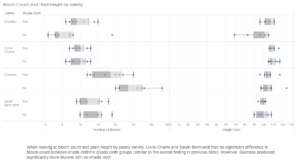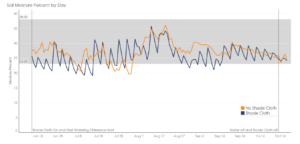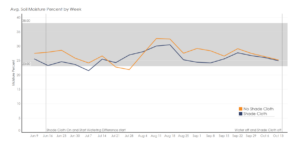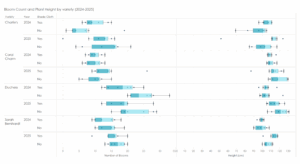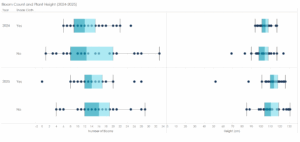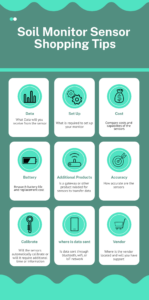Final report for FW23-420
Project Information
Water is a limited resource in the drought prone US West. Although peonies use relativity less water than most cut flower crops once they are established, they still require consistent watering to produce new eyes and good bloom size. Shade cloth has been shown to reduce water needs in crops like fruits and vegetables (1).
Our project will test the use of shade cloth as a way of reducing the amount of water needed to establish our plants (planted fall 2021) while still producing comparable blooms to the control group being watered with one-inch of water per week.
Our farm is fortunate to be part of a large community of cut flower growers in our state (over 100). We feel that this project would be very beneficial to many of the new growers with 1 to 3 years experience (which is about 60-75% of the total growers). The new growers will be able to use this project's outcomes to help them establish their own peonies on their farms in a way that will use less water resources without sacrificing production.
Our farm is located close to the old railroad line. Kaysville used to have several peony farms and the railroad would pick up the flowers and take them in to the capital city of Salt Lake about 20 miles south. This project would help our community benefit from learning about flower farming, growing their own peonies and water conservation.
The project's information will be shared to members of the Utah Cut Flower Farm Association (UCFFA) via a Zoom webinar. UCFFA hosts monthly presenters who share information with the group that is relative to growing cut flower farms. We will be hosting a farm tour in the June of 2025 to share our project with the community.
- Reduce the amount of water given to peony crops by half with the use of 50% shade cloth
- Record data of irrigation volume, soil moisture and compare bloom production and size to the control group
- Provide education to other growers in the US Mountain West by providing the data to growers though a Zoom presentation and social media
- Host a Farm tour to educate the public on the impact of water conservation through shade cloth usage.
| Date | Activities | Team Members |
| March-April 2023 | Purchase supplies and make conduit hoops | Britin |
| May- June 2023 | Place hoops and shade cloth over peonies that have finished blooming | Britin |
| May-June 2023 | Place soil monitors | Britin |
| May-October 2023 | Collect weekly soil monitor data | Britin |
| October 2023 | Remove and store hoops and shade cloth | Britin |
| April-May 2024 | Compare bloom production and size to control group | Britin and Melanie |
| May-June 2024 | Place hoops and shade cloth over peonies that have finished blooming | Britin |
| May-October 2024 | Collect weekly soil monitor data | Britin |
| October 2024 | Remove and store hoops and shade cloth | Britin |
| October -November 2024 | Compile weekly soil monitor data | Britin |
| April-May 2025 | Compare bloom production and size to control group | Britin |
| May-July 2025 | Collect and analyze bloom production data | Britin and Melanie |
| June 2025 | Farm tour showcasing the project, peonies and water conservation | Britin and Melanie |
| July 2025 | Presentation to growers on the project and how to implement it. | Britin and Melanie |
Cooperators
- - Technical Advisor
- - Producer
Research
Our project has Four main objectives.
- Reduce the amount of water given to peony crops to 50% of the normal irrigation volume with the use of 50% shade cloth.
- Record data and soil moisture and compare bloom production and size to the control group
- Educate other growers on how to implement project
- Farm tour to educate the public on the impact of water conservation with the use of shade cloth.
Project was conducted at Cherry Petals Flower Farm. The farm is located in the small city of Kaysville, UT. It is on approximately ⅓ of an acre for the growing portion. The lot which also contains the primary residence is .83 acres. The project studied close to 90 peonies, about 30% of the total peonies the farm has. Our small field is divided by a main walkway with rows of peonies on either side. We tested 9 rows of peonies on both the north and south side of our main walkway. The other peonies not covered in shade cloth were used as the control group. These peonies include rows on the north side of the path. Of the peonies we tested in this project there are about 30% early coral variety, 30% early white variety, 30% late pink variety and 10% mid blooming varieties. These varieties are also in our control group.
The use of shade cloth has been studied for reducing water requirements on vegetables and has been found to reduce the need by about 50%. There is not available research that has been done on the use of shade cloth on peonies or on any cut flower perennials. We are hopeful that the success vegetable growers have had in regards to reducing water on their crops using shade will also apply to cut flowers, specifically peonies and that the establishment and bloom quality of the plant will not be affected. In a fruit and vegetable study done in 2017 they found that "shading increases relative humidity under the structure and decreases wind. An increase in relative humidity decreases evaporation which causes soil and plants to retain more moisture under shade. There are decreased water requirements for crops grown under shade. (1)" A soybean study also found that "the shade cloth wind screen decreased water stress and water use. (2)"
The first objective began May/June of 2023 when the peonies finished blooming. Low hoops were placed over the test rows, we also used t-posts and woven shade cloth to set up shade on larger areas. Hoops were made from electrical conduit and a hoop bender conduit bender. This relatively accessible material and method will allow for even the smallest of growers to imitate this project. 50% shade cloth was placed over the low hoops. Drip line was placed in early spring and the reduction of water began when the shade cloth is placed. Peonies usually require 1 to 2 inches of water per irrigation (about every week). Deep watering encourages deep root development. Drip irrigation works well for peonies as it keeps the foliage dry, reducing risk of disease. (3) " Water for the rows treated with shade cloth will be reduced to 1"-2" every other week. Half the amount that was used for the control group. The shade cloth was removed each fall after the peony plants had been cut back.
The second objective used soil monitors that were placed in 5 different rows of the peonies to collect data. Data was recorded during the growing season. Test peony plants were compared to the control group in spring 2024 and spring 2025. The comparison looked at bloom quality including the number of blooms per plant and plant length. We also observed the overall plant health through visual observations on greenness, leaf heath and if any disease is present.
The third objective happened in July 2025; were we presented to growers data that was collected with the soil monitors as well as the bloom comparisons. This education will also show water savings of implementing the project.
The fourth objective was completed during our June 2025 farm tour that showed the impact that the shade cloth made to our farm and to showcase the drought resistance of peonies and their blooms.
We had 4 project objectives and below shows the progress on those objectives.
- Shade Cloth placed in June 2023. Shade cloth crops were irrigated at 50% irrigation and control field peonies were irrigated at 100%, this was done by running the drip for half the duration much as the field peonies. This objective was repeated in June 2024.
- First bloom and plant comparison will happen in May 2024. As of February 2024 sensors working and collecting data in field. Data was collected in June 2024 for plant comparison and the sensor data for the year was gathered December 2025. Our findings are below.
- Zoom Meeting July 17, 2025 -presented our findings from this project to the Utah Cut Flower Farm Association.
- Farm June 5, 2025
The field study was established as equipment became available in 2023. Our project started with getting shade cloth established. This was done through purchasing a hoop bender from Johnny's Selected Seeds to bend the electrical conduit into 3’ wide hoops. This was relatively easy but much easier if you have two people. Ros had the hoops placed at about 5-8 feet apart and placed with woven 50% shade cloth. We also applied a method of using t-posts to attach a section of 50% shade cloth over 5 rows. Both were relatively easy to install but we learned that the t-post method ended up being less costly than the hoops because we were able to cover 5 rows at one time with this method.
We encountered significant, unanticipated challenges with soil moisture sensors, and learned that getting sensors in a timely manner was very difficult. The newness of this technology, paired with the newness of supply companies working with the public/farmers resulted in delays in product availability and lack of package bundling and information on components. For example our sensors were ordered June 5th and there was an 8- week delay for the sensor to arrive, Moreover, the sensors did not work upon arrival. In fact, the sensor required another component that was not advertised. After this additional component, and hidden cost, was purchased, the gateway, turned out to be defective. It was not until February 2024 that all the components were received and working properly. It took a significant amount of time, even though there was extensive communication with the company throughout the process. This experience illustrates the newness of soil moisture technology for the public and the challenges to implement it for farmers.
Because of the struggle of the soil monitors in 2023, we purchased a simple soil moisture meter gauge in September to start to collect some preliminary data on soil moistness. The gauge measured the soil moistness on a scale of 1-10 from dry to wet. See table #1 for back up data.
Table #1: Soil Moistness
|
Sensor No. |
Soil Meter |
Description |
|
Average Soil Moistness Readings in September |
||
|
Sensor #1 |
5.25 |
Shade Structure North Field |
|
Sensor #2 |
6.5 |
Shade Hoop North Field |
|
Sensor #3 |
2.5 |
Control North Field |
|
Sensor #4 |
4 |
Shade Hoop South Field |
|
Sensor #5 |
3.75 |
Control South Field |
|
Average Soil Moistness Readings in October |
||
|
Sensor #1 |
6.5 |
Shade structure North Field |
|
Sensor #2 |
7 |
Shade Hoop North Field |
|
Sensor #3 |
6 |
Control North Field |
|
Sensor #4 |
6 |
Shade Hoop South Field |
|
Sensor #5 |
5.5 |
Control South Field |
|
Average Soil Moistness Readings in November |
||
|
Sensor #1 |
6 |
Shade structure North Field |
|
Sensor #2 |
7 |
Shade Hoop North Field |
|
Sensor #3 |
6 |
Control North Field |
|
Sensor #4 |
6.5 |
Shade Hoop South Field |
|
Sensor #5 |
6.5 |
Control South Field |
*Table data was collected using a simple Sonkir soil moister gauge. The meter scales from 1-10, 1 being Dry and 10 being saturated.
Despite the challenges with the sensors, we implemented an irrigation schedule from June-October. Drip irrigation under the shade cloth ran every other watering session.
Water Schedule for control: Every 3 days applying approximately 0.5 inches of water each time
Low flow emitters at 5-6 hours at a time with sandy clay loam soil.
Shade cloth received half the amount: an average of 0.75 inches a week vs 1.5 inches per week for the control.
Shade cloth was removed in November and peonies were cut back to the ground. Irrigation was shut off the first week of October, so from that time all peonies received the same moisture levels, and the test peonies will start the 50% irrigation schedule again when the shade cloth is placed in June, after the peonies have finished blooming.
Our first peony comparison data was collected June 2024. We will note that we had a late winter snow storm that damaged about 80% of the crop but we were able to gather data on plant height and number of blooms. Data in research outcome section.
We also had our soil monitors up and running for the 2024 growing season.
The data for our peony plant comparison is below: We did experience an above average precipitation year for 2023/2024. So far the winter of 2024/2025 has been extremely dry.
Data for the soil monitors are below.
Both shade and non-shade cloth crops remained healthy throughout the growing season, with the exception of a few Sarah Bernhardt peonies under the shade cloth section had powdery mildew at the end of the growing season.
As of 2024 the data showed that bloom count and height are not significantly affected in the shade cloth vs no shade cloth groups.
Below compares data of peony plants for both 2024 and 2025. We found that there was no significant difference in the control vs shaded plants. which means that we were able to get the same production from our shaded plants receiving 1/2 the amount of water as the control group.
Research Outcomes
Although I didn’t go into this grant with the intention of giving advice on soil monitors, my experience has made me feel that getting simple soil moisture monitors is difficult for a small farmer. I started my research on which ones to purchase, ensuring that they were affordable and simple. I initially was going to try an onset data collector but they were back ordered for months and I wanted to get going on collecting data. I ended up finding a cool sensor called “sensoterra” that would collect the soil moisture data and would make that data very accessible through an app. As stated above, I ordered the monitors on June 5th, received them at the end of July and installed the sensors in the field. After the sensors were installed they failed to connect to the network and I emailed multiple times until finally getting a response that we needed to order a gateway in September. The gateway was ordered and not received until November. After multiple unsuccessful attempts, the gateway would not connect to the sensors, and in January via a phone call with the vendor we determined that the company needed to send a new gateway. The new replacement gateway arrived in February and we are now getting data on the app.
Now that we have used the sensoterra monitors for this project we feel like we can recommend them as a suitable soil moisture monitor. The data collection was very easily downloaded from their website and the moisture was updated every hour through their app which was very convenient to check moisture right from your phone. We also compared the readings to the soil moisture meters from Utah State University and they were within .5-1% of all of the readings so we were able to get accurate readings from the sensoterra monitors.
Observations we had during the project:
Soil under the shade cloth felt and looked more moist than soil in the field.
Die-back timing in the fall for the peony plants didn’t seem to differ between the shaded plants and the plants in the field.
Both shade and non-shade cloth crops remained healthy throughout the growing season, with the exception of a few Sarah Bernhardt peonies under the shade cloth section had powdery mildew at the end of the growing season.
Because the shade cloth was added after blooms they didn’t experience stretching for the sun as they would if planted under a tree or had shade cloth the entire year.
We chose to add shade cloth after blooming for ease of harvesting and because the heat and higher water usage doesn't happen until they are done blooming.
For better shade coverage we recommend using the emt conduit hoops with the woven shade cloth as you can shade the sides of the plants and fasten it more securely. We also feel that it protects better from wind and helps lessen the drying effects of wind.
We would love for more studies to be conducted using shade cloth as we feel that other crops could benefit from the use of shade cloth and that water could be continued to be used further to see how much of a deficient plants can handle when they don't have such a high heat stress.
Education and Outreach
Participation Summary:
Our public farm tour happened June 5th. We had different stations with education booths and family activities. We shared the data from the project and demonstrated how simple it was to put up shade cloth. Below are the posters and maps we used for the event.
Dr. Melanie Stock and Britin presented the findings from the project via zoom to the members of the Utah Cut Flower Farm Association on July 17th.
We had so much fun at the public farm tour and being able to share our results from the project. Most participants were home gardeners and were interested in how to implement the shade cloth in their own gardens. We had a stations at our farm tour with some activities for families. We had a shade cloth demonstration, Dr. Melanie Stock had a station going over the results of the study. We had a grad student from Utah State University that talked about soil and soil sampling. We had over 85 people come to the farm tour.
We also gave a presentation to the Utah Cut Flower Farm Association over zoom showing all the results. Below are the slides to the presentation we gave. It was also posted on the member site for their 150+ members to view.
Education and Outreach Outcomes
Our farm tour showing how simple and effective shade cloth was at reducing water needs was a big eye opener for our local guests. Seeing how easy it was to install the shade cloth really helped the participates see how they could use it in their own gardens to reduce water needs even on a small scale.
At the farm tour we also had fact sheets that included the benefits of shade cloth on fruits and vegetables along with our study on peonies. We also loved being able to show the actual data from our soil moisture sensors. That data really helped show how effective the shade cloth was.
During our zoom call with the UCFFA(Utah Cut Flower Farm Association) we had a lot of farmers interested in the soil moisture sensors because sometimes irrigation can be ambiguous and its hard to know how much to give your different crops. Most of the members of the UCFFA are micro farmers meaning they grow on less than 5 acres. With small plots and small budgets it was important for them to see that there was a somewhat affordable option to be able to gather the important soil moisture data.
We have continued to share our information about the project through social media to continue to educate about the benefits of shade cloth.
We feel that there is always more to study and share and look forward to continuing talking to interested parties about our project through social media, conferences and events here on the farm.
Everyone who attended our farm tour now has the skills to set up their own shade cloth through our demonstration.
We also feel that sharing with our farmer friends individually , through zoom or on social media about the benefits of shade cloth and monitoring soil moisture has helped increase knowledge and attitudes towards water use.

